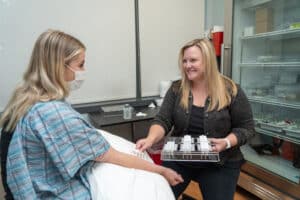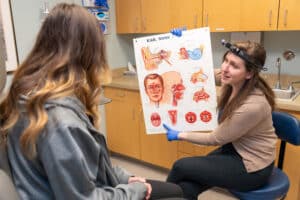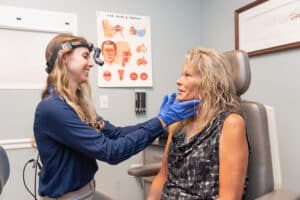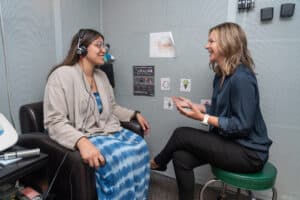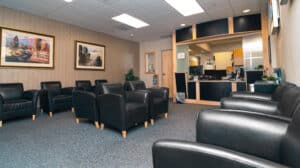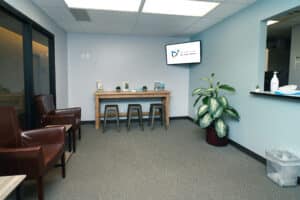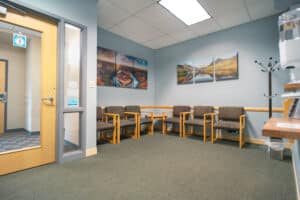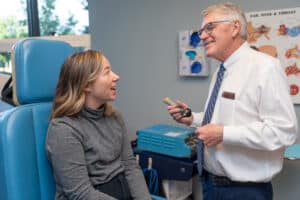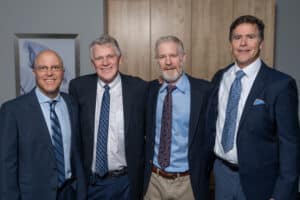Nose & Sinus Treatments for Better Breathing and Comfort
Your nose and sinuses are extremely important to your health and overall well-being. Together they filter the air we breathe, removing dust, germs and irritants. They also warm and moisten our airflow to keep our lungs and respiratory tract from drying out. Your nose also contains the nerve cells that help us sense smell. When there is a problem with either our nose or sinuses, the whole body can suffer. For example, a stuffy nose from the common cold can make it hard to breathe, sleep or be comfortable.
Causes of Chronic Nose & Sinus Symptoms
Many problems besides the common cold can affect the nose and sinuses. They include some of the following:
Deviated Septum
Deviated Septum is frequently caused by facial trauma such as a blow to the nose/face. It can also occur just from the way the septum develops as a person grows. A deviation in the septum can cause breathing obstruction and congestion, and sometimes lead to sinusitis issues. In most cases a deviated septum can be corrected with an outpatient surgical procedure known as a septoplasty.
Nasal Fracture
A nasal fracture is the result of a break in the cartilage or bone of the nose. A broken nose will often be accompanied by a nose bleed, swelling and even “black eyes”.
If you’ve sustained an injury to your nose, it is important that you visit us or seek medical attention somewhere within seven to ten days of the injury because the bones and cartilages can be moved back into their original position before any scarring sets in during this early post-traumatic time frame. Depending on the extent of injury, treatment can involve doing nothing (other than rest and caution not to bump your nose), stabilization, re-positioning of the bones or septum, or sometimes surgery.
Epistaxis (nosebleeds)
The nose has a high concentration of blood vessels combined with delicate/fragile nasal membranes. Common causes of nosebleeds include dry climates (like Colorado!!), injury to the nose or nasal mucus membranes, medications that thin the blood, infections, high blood pressure/hypertension, alcohol abuse, and allergic and non-allergic rhinitis.
You should go to the doctor or emergency room if:
- You experience heavy bleeding or significant blood loss.
- You experience a headache, or a fever while having a nose bleed.
- You faint or feel weak from blood loss.
- Your baby has a nose bleed – contact your pediatrician.
- You have any concerns
Treatment of nosebleeds can involve moisturizing the membranes, avoiding trauma (i.e. no heavy nose blowing, no tissues or fingers in the nose), chemical cauterization, electrocautery, local application of blood clotting medicine, and in some cases nasal packs for persistent bleeds. Though somewhat rare, severe cases are occasionally admitted to the hospital for further assessment including surgical intervention.
Allergic Rhinitis
Allergic Rhinitis occurs when the body’s immune system over-responds to specific, non-infectious particles such as plant pollens, molds, dust mites, animal hair, industrial chemicals (including tobacco smoke), foods, medicines, and insect venom. During an allergic attack, antibodies (Immunoglobulin E- IgE) attach to mast cells (cells that release histamine) in the nasal mucous membranes. Once IgE connects with the mast cells, a number of chemicals are released. One of the chemicals, histamine, opens the blood vessels and causes swollen membranes, congestion, sneezing, skin swelling and redness, watery eyes, and itching.
Seasonal allergic rhinitis or hay fever occurs in certain seasons every year- like spring or late summer. Hypersensitivity to ragweed, is the primary cause of seasonal allergic rhinitis in 75% of all Americans who suffer from this seasonal disorder. People with sensitivity to tree pollen have symptoms in late March or early April; an allergic reaction to mold spores occurs in October and November as a consequence of falling leaves. At our Boulder Allergy Clinic we are able to perform comprehensive allergy testing to help identify causes of allergic rhinitis among other allergy reactions.
Non-Allergic Rhinitis
Non-Allergic Rhinitis does not depend on the presence of IgE and is not due to an allergic reaction. The symptoms can be triggered by cigarette smoke and other pollutants as well as strong odors, alcoholic beverages, and viruses (common cold), or bacteria.
Sinusitis (Acute, Sub-acute, or Chronic)
The sinuses are located behind the cheeks, eyes, forehead, and nasal bones. The sinuses are air filled spaces lined with mucus membranes. Sinusitis occurs when there is inflammation of the tissue lining the sinuses, the sinus mucus membrane, and can occur in a single sinus or multiple sinuses. The source of the inflammation can be viral, bacterial, fungal, or even non-infectious in some cases of chronic sinusitis. Healthy sinuses circulate air and allow mucus to drain.
When the sinus is blocked, mucus is trapped and inflammation occurs, which is usually accompanied by an infection. Acute sinusitis is defined as symptoms lasting up to 4 weeks, Sub-acute sinusitis implies symptoms lasting 4 to 12 weeks, and Chronic sinusitis is defined as symptoms lasting over 12 weeks.
The signs and symptoms caused by sinusitis are varied and may include:
- Facial pain and/or pressure
- Nasal congestion or fullness
- Difficulty breathing through the nose
- Discharge of yellow or green mucus from the nose
- Teeth pain
- Loss of the sense of smell or taste
- Headache
- Fatigue
- Sore throat
- Bad breath
- Cough
- Rhinitis/sinusitis
To clarify the relationship between rhinitis (inflammation in the nose) and sinusitis (inflammation in the sinuses), studies have concluded that sinusitis is often preceded by rhinitis and rarely occurs without concurrent rhinitis. The symptoms, nasal congestion, obstruction/discharge and loss of smell, occur in both disorders. Rhinitis often occurs first before the inflammation spreads to include the sinuses (sinusitis).
Nose & Sinus Procedures:
In-office Balloon Sinuplasty
In-office balloon sinuplasty is a safe and effective way to alleviate chronic sinus problems. Those suffering from chronic sinus pressure and pain, headaches, frequent sinus infections, decreased sense of smell and unrelenting congestion among other complaints, can benefit from the long-lasting effects of in-office sinuplasty.
Unlike traditional sinus surgeries which often remove bone and tissue to restructure the sinuses, balloon sinuplasty is less invasive and helps sinuses drain better by simply expanding the passageways with a balloon, very similar to the technique used to dilate arteries in angioplasties.
Learn more about Balloon Sinuplasty on our page dedicated to this revolutionary procedure here: Learn more about Balloon Sinuplasty and take the Balloon Sinuplasty Quiz to find out if you are a candidate!
Endoscopic Sinus Surgery
Endoscopic sinus surgery allows ENT specialists to visualize and treat problem areas within the sinus cavities. Through the use of a thin, flexible fiber-optic tube, our Boulder Valley ENT specialists can access all the major sinuses through the nasal cavities without the need of external incisions. Endoscopic Sinus surgery is a less invasive approach than traditional sinus surgery and has drastically decreased the amount of discomfort associated with sinus procedure while reducing scarring and recovery time.
Candidates for endoscopic sinus surgery typically include those who suffer from chronic sinus infections or inflammation caused from blocked sinus passageways or diseased tissue. Complications from a deviated septum, abnormally large nasal turbinates, or nasal polyps can also be corrected at the same time as
endoscopic sinus surgery.
The goal of endoscopic sinus surgery is to identify and correct areas of reduced airflow, obstruction or poor drainage. Outcomes of endoscopic sinus surgery include improved breathing and sense of smell along with a decrease in the frequency and severity of sinus infections, headaches, and facial pressure.
Anesthesia for endoscopic sinus surgery can be done generally or locally. Through tiny incisions made inside the nostrils, specialized instruments are used to remove or correct obstructions such as polyps and scar tissue. Nasal septums deviated by past trauma can be straightened through endoscopic sinus surgery. It can also correct enlarged turbinates, which lie within the nasal passageways. Turbinates filter and moisten air inside of the nose but sometimes as a result of allergies they become abnormally large and interfere with breathing and drainage. Balloon sinuplasty can be combined with endoscopic sinus surgery when the expansion of passageways is needed.
Most patients who undergo endoscopic sinus surgery can go home the same day with only minimal nasal packing. Post-surgical pain is typically less than traditional sinus surgery and overall endoscopic sinus surgery is much more tolerable. Recovery is short and usually includes a few follow up visits to remove packing and insure proper healing.
Septoplasty Surgery
Also known as nasal septum repair, septoplasty surgery is used to correct problems in the nasal septum, the wall of bone and cartilage that separates the two nasal passageways. By straightening and realigning the septum in the middle of the nasal passageways, septoplasty can drastically improve breathing and overall quality of life for many. Incisions are small and are made inside the nostrils so external scarring is not an issue with septoplasty.
Septoplasty surgery can be performed under general or local anesthesia depending on patient preference, overall health and the medical discernment of the ENT specialist. It is typically an outpatient procedure, meaning an overnight stay is not needed, but the duration of surgery may vary depending on what needs to be corrected.
Septoplasty can also be done at the same time as a rhinoplasty, the cosmetic surgery also known as a “nose job”. Deviated septums, especially those from trauma, can cause abnormalities or some dissatisfaction in the external structure or appearance of the nose so it is not uncommon at all to see rhinoplasties and septoplasties performed together.
After septoplasty surgery individuals experience improved breathing and often improved sleep quality. Nasal and sinus infections are often less frequent and less severe. Uncontrollable nosebleeds can also be treated by septoplasty surgery. Not only is function improved with septoplasty surgery, but form and appearance may be as well.
Turbinate Reduction
When the turbinates of the nose become chronically irritated and inflamed from allergies or infection, surgical reduction is often recommended. This quick and simple procedure is often done in-office in 10-20 minutes and under local anesthesia. The procedure uses radiofrequency which is delivered through a needle-like instrument that is inserted into the turbinate. The energy causes a “controlled damage”, to stimulate proper healing which aims to reduce the size of the inflamed turbinates. The reduction of the turbinates improves airflow through the nose and reduces that congested feeling. A shaver device is a powered instrument that can be used during turbinectomies especially for the removal of massive polyps in the nose and sinuses. Occasionally turbinectomies may be performed in the operating room if necessary.
Epistaxis
When a bloody nose fails to stop after 15-30 mins of home remedies or if they continuously recur, certain medical procedures may be necessary. Here at Boulder Valley ENT, we are happy to provide various treatments for persistent or frequent epistaxis. Common procedures that we use to treat bloody noses include: nasal packing, cauterization, ligation, septoplasty, and/or medications if necessary. Which procedure depends on the origin and nature of the bleed.
Contact Us Today!
At Boulder Valley Ear, Nose & Throat Associates, we provide the highest quality patient care in a friendly, professional atmosphere. We emphasize personalized customer service, availability, efficiency, honesty and integrity, and attention to detail. We strive to do things the right way at every level, all the time. If you suffer from chronic nose and sinus related symptoms, contact us today!

